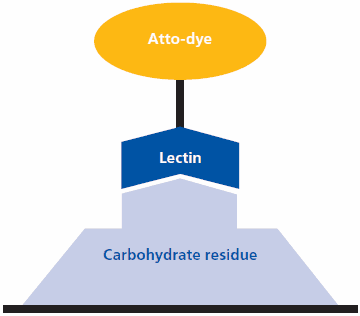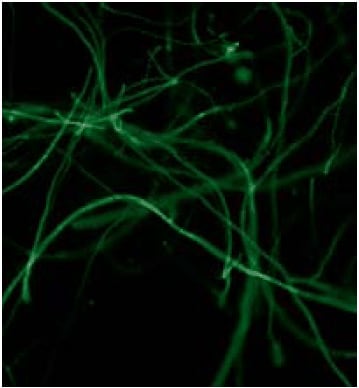Early Detection of Fungal Hyphae on Bread by Fluorescently Labelled Lectins
Monika Baeumle, Product Manager Biochemistry monika.baeumle@sial.com
Bernhard Schoenenberger, Supervisor R&D; Jakob Zbaeren, Inselspital Bern, Switzerland
Food quality assurance and control have gained importance as factors of concern to public health. Perishable foods are of particular focus for routine food analysis. One of the most critical issues is the contamination of bread and fruits by fungi and molds, as these food items are especially susceptible to mold development. Specific fungal species and the mycotoxins produced can adversely affect human and animal health, and early identification of negative fungi can allow contaminated products to be removed before entering the food chain. Here, we demonstrate a highly specific technique for early identification of fungi in bread via direct fluorescence detection, using fluorescently labeled lectins.
Lectins are ubiquitous proteins or glycoproteins that can be isolated from plant and animal sources and can bind to specific carbohydrate moieties. Due to their high affinity to sugar residues, lectins have become important tools for sensitive detection of cellular carbohydrates, revealing subtle alteration in glycosylation between otherwise indistinguishable cells. This allows the identification of cellular surface structures, e.g. cell surface, cytoplasm, and nuclear structures. Furthermore, lectin affinity binding allows for the detection of fungi in food, such as bread or fruit.
The recently developed Atto-dye labeled lectins have many applications, including carbohydrate, mitogenic, and histochemical studies, and food analysis techniques. Atto-dyes have very bright fluorescent signals and high photostability, which enable a direct one-step sample binding protocol. Time-consuming multi-stage amplification procedures are not required with Atto-dye lectin conjugates (see Figure 1).

Figure 1.Direct one-step binding of fluorescently labelled Lectins
Lectin binding was performed using a smear preparation of bread containing fungi. The lectin conjugate used was Phytolacca americana-Atto 488 conjugate (Cat. No.39905 ). The conjugate was diluted 100x in PBS buffer (pH 7.4) before incubating with each specimen for 30 min. After washing to remove any unbound lectin, the samples were examined using a microscope equipped for epifluorescence with a 450–490 nm excitation bandpass filter and a 520–560 nm barrier (emission) filter.
The images obtained show very specific labeling of fungi that are present in the bread samples (see Figure 2). The image demonstrates clear and fine filaments of the fungi with typical mycelium, and individual fungi cells are visible. The separating cross-walls (septa) structures show a slightly brighter fluorescence, which is due to a higher concentration of target carbohydrates. No background is observed.

Figure 2.Fluorescence microscopy of a smear preparation of bread containing mould. The target carbohydrate subunit chitotriose [(GlcNAc)3] of the fungi are specifically bound to lectin from Phytolacca americana Atto 488 conjugate (green). Image by J. Zbaeren, Inselspital Bern, Switzerland.
Fungal cell walls contain chitin, a polymer of β-(1->4) linked N-acetyl-D-glucosamine, while animal and plant cells do not synthesize chitin. The lectin Phytolacca americana targets the fungal carbohydrate fragment chitotriose [(β-N-acetyl-D-glucosamine)3, (GlcNAc)3] shown in green (λex 485 nm). Due to the lack of the target carbohydrate chitotriose in the bread carbohydrates, no specific interaction between the lectin Phytolacca americana and the bread residue is observed. The bright and stable fluorescence properties of the Atto 488 dye provide a strong fluorescent signal without requiring additional amplification steps. The presence of surface fungi can be detected long before visible surface mold develops. These results confirm this approach to be a successful and reliable way to detect mold on bread. This fascinating application may encourage scientists to investigate the specific binding of lectins to other carbohydrate targets for food analysis.
The following Atto-dye lectin conjugates are now available from Sigma® Life Science. Additional lectins and lectin conjugates available from Sigma Life Science may be found at sigma-aldrich.com/enzymeexplorer
如要继续阅读,请登录或创建帐户。
暂无帐户?